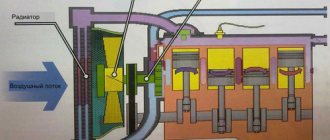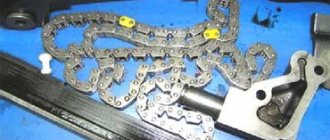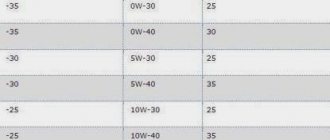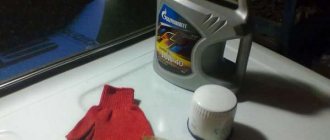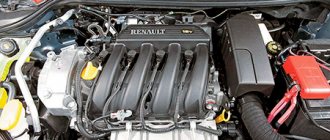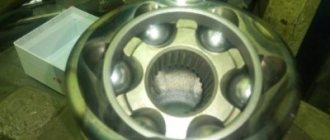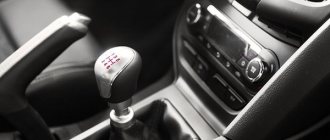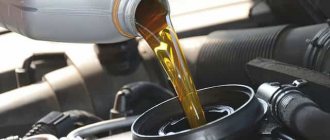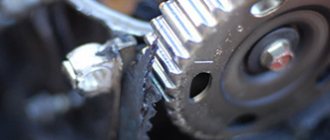Volkswagen Tiguan 2.0 TDI › Logbook › Choosing engine oil
One of the most important problems of almost every car enthusiast is the correct choice of engine oil.
I will try to describe in sufficient detail and clearly from my own experience how I solved this problem. Let's start with the fact that in 99% of cases on our public roads, diesel Tiguans of the first generation (restyling) are equipped with an engine marked CLJA. The fundamental difference between this internal combustion engine and previous modifications is that it is not equipped with a particulate filter, and therefore is free of the accompanying problems that arise due to low-quality fuel in the Russian Federation. Actually, that’s why the soot was removed for the Russian market (Ecology? Oh, what nonsense). Based on this, in the operating manual for this type of internal combustion engine, VAG recommends using 2 types of motor oils with VW approvals 505.01 and 507. You can find out the modification of your engine in the vehicle registration certificate, service book and by the sticker on the driver's pillar of the body.
So, at the manufacturer’s factory, the internal combustion engine was filled with original VAG Long Life engine oil with a tolerance of 507 with a viscosity of 5w30. However, it was almost immediately revealed that this permit would not work in the Russian Federation, for the same reasons of the notorious fuel quality and, in addition, difficult operating conditions (dust, temperature changes, etc.). As a result, official dealers by default began to fill in the original VAG Special Plus engine oil with a tolerance of 505.01 and a viscosity of 5w40. Everything would be fine, but, unfortunately, the prices for maintenance at the dealer are far from low, especially for those who drive often and a lot, plus a lot of people prefer to do the maintenance of their car themselves in the garage. The original VAG Special Plus oil does not have any protection against counterfeits at all, therefore, it will not be difficult to run into counterfeit oil. I personally encountered a situation where the cap of a canister came unscrewed along with the locking ring, and I immediately felt somewhat sad.
More details about the WV 505.01 and 507 approvals. The main difference here is in the requirements for motor oil. I will not delve too deeply into the terrible parameters of ash content, sulfur content, etc., I will only say that for the VW 507 approval these requirements are an order of magnitude higher than the requirements for oil approval WV 505.01. Approval WV 505.01 is suitable for diesel units equipped with unit injectors. According to the approval requirements, the characteristics of the engine oil should not change for 250 operating hours (15 thousand km according to the manufacturer). It is important that there is no original oil with VW 505.01 approval and viscosity 5w30 (we’ll return to viscosity later). The WV 507 approval is suitable for all types of diesel engines. According to this tolerance, the characteristics of the engine oil should not change for 650 operating hours (35 thousand km according to the manufacturer). According to numerous tests carried out in our country, it was revealed that 507 tolerance oils are capable of maintaining the declared characteristics for 300-350 operating hours. It is important that 507 tolerance oils with a viscosity of 5w40 do not exist.
Now a little about viscosity. According to reviews from many owners of diesel Tiguans using oils with a viscosity of 5w30, the engine runs smoother, quieter, has lower fuel consumption and greater performance. Which is logical from the point of view of the physics of the processes occurring in the internal combustion engine. However, you need to pay more attention to the oil level, since, all other things being equal, 5w30 is more susceptible to waste than 5w40.
Note that most oil manufacturers have several product lines, usually a basic segment and a premium one. Like, for example, Mobil (Mobil Super - basic, Mobil 1 - premium), Castrol (Magnatec - basic, Edge - premium), etc. So, all oils with VW 507 approval will always belong to the premium segment, and 505.01 to the basic one.
Finally, conclusion, for the previously described reasons, I decided to switch from the original Special Plus 5w40 oil to 507 tolerance oil with a viscosity of 5w30 and replace it every 250-300 engine hours. Choosing a brand was a very simple task, fortunately there is an oil-club that constantly tests the characteristics of motor oils and compiles top lists. My choice fell on Mobil 1 ESP 5w30 oil. Briefly about the reasons: — compliance with VW 507 approval; — new, top-end protection against counterfeiting; — ease of acquisition; — operational characteristics.
In conclusion, I recommend changing the oil based on engine hours (change every 250-300 engine hours), especially in a large city. Fortunately, the Tiguan's on-board computer allows you to do this. If you have unforeseen circumstances and had to remove the battery, you can always estimate the average speed. For example, for my city with a population of just over 500 thousand, the average speed in winter in the city, taking into account warming up, is 24 km/h (24 km/h * 250 engine hours = 6 thousand km). Here is the approximate oil change interval in winter in the city.
For 2-stroke engines of motorcycles and cars
- — Smokeless oils for two-stroke engines of motorcycles and other machines with improved engine cleanliness characteristics compared to JASO FC, meeting the highest requirements for use in Japan.
- — Smokeless oils for two-stroke engines of motorcycles and other machines, meeting the basic requirements for use in Japan.
- — Oils for two-stroke engines of motorcycles and other machines that meet the minimum requirements for use in Japan.
- FA - Oils for two-stroke engines of motorcycles and other machines, intended for use in developing countries.
Volkswagen Tiguan 1.4 TSI TURBO vegetable › Logbook › Oil temperature
Strictly speaking, the concept of “critical oil temperature” does not exist. The temperature of parts is different in different parts of the engine. For example, the oil temperature in the oil pan can be 100-120 degrees. At the same time, the temperature of the piston rings, washed by oil, is 350 - 400 degrees, the exhaust valves - up to 700, the turbine driven by exhaust gases - even higher.
The oil circulates through all these heated zones. If oil is heated to such temperatures in a static state, it will oxidize intensively. But due to the fact that the oil moves very quickly, the degree of oxidation for each individual pass of such areas is not very high, and the oil as a whole retains all its properties until the end of the replacement interval, i.e. until the next maintenance. Moreover, in addition to all other functions, it also performs the function of cooling these heated zones. Suffice it to say that in modern powerful engines, oil for cooling the pistons is pumped through a special nozzle under the piston bottom.
Let me note one more fact: in the SAE table, which determines the viscosity classes of motor oils, there are requirements for viscosity, determined at 150 degrees C under conditions of very rapid shear in friction pairs. So the 120 degrees C you mentioned are relatively mild operating conditions for engine oil.”
vw-golfclub.ru/forum/showthre…3%F0%E0&page=4
And here is the answer to my written appeal to FVG RUS: Dear, good afternoon. First of all, thank you for choosing a Volkswagen vehicle. We have carefully read your request and would like to respond with the following. During normal operation - if the engine has reached its operating temperature, then the engine oil temperature readings can be in the range of 80-110C. If the engine is under heavy load and the outside temperature is high, the readings may be even higher. There is nothing wrong with this until the warning light in the instrument cluster lights up or starts flashing. If you have any other questions, we will always be happy to answer them. Sincerely, Andrey Dyatlov Technical consultant Volkswagen Coll.
So IMHO the oil won’t do anything up to 120 degrees. Unless, of course, you keep it at this temperature all the time. Last summer, in the heat of the forties at a speed of 130-140 km/h, the oil was 115-117 degrees. You slow down the speed to 100-110, the temperature drops to 110-112... and without annealing it stays somewhere around 102-107.
Any driver simply must know how to change oil or other fluids in his car. Some people are doing this for the first time, using a manual, while others are already experienced businessmen. However, despite the quality and speed of work, there is one factor from which not a single car owner is immune. It's a fake copy! Indeed, at present there are many companies producing oils, antifreezes, various lubricants, and they all advertise their products, praising their quality. But this is not a guarantee that the purchased product will meet your expectations. It is not uncommon for a substance to lose quality and properties a couple of weeks after replacement.
To avoid such a problem, you need to purchase refill materials for Volkswagen Tiguan from reputable companies. It is best if it is an official dealer, but it is not available in every city. In this case, you can buy the liquid from well-known companies with a good reputation and reviews. For example, these could be Shell, Castrol, ZIC, G-Energy, Lukoil, etc. motor oils. or antifreeze - “Tosol-Sintez”, Liqui Moly, Motul, etc.
Volume of oils and liquids Volkswagen Tiguan
| Filling/lubrication point | Filling volume, l | Name of oil/liquid | ||||||
| Fuel tank | 64 | AI-95 and higher; Diesel fuel with a cetane number of at least 50 | ||||||
| Engine | Petrol | 1400 cm3 | 4, 0 | Class: API SM and higher; Viscosity: 10W-40 SM; 0W-50SN | ||||
| 2,000 cm3 | 5, 7 | |||||||
| Diesel | 2,000 cm3 | 5, 5 | VW LongLife III 5W30 Viscosity: depending on region | |||||
| Brake system | 1, 15 | DOT 5.1; DOT 4 | ||||||
| Air conditioner | refrigerant | 0, 66 | HFC-134a | |||||
| oil | 0, 12 | FD46XG | ||||||
| Transmission | Automatic transmission | Number of gears | ATFG 055025A2; DEXRON III | |||||
| 6 tbsp. | 7, 0 | |||||||
| Manual transmission | 6 tbsp. | 2, 4 | VAG G052 171 A2; Castrol 75w90 API GL4 | |||||
| Robotic gearbox | 6 tbsp. | 7, 2 | ||||||
| VAG G 052 182 A2; VW TL 521 82; Pentosin FFL-2 | ||||||||
| 7 tbsp. | ||||||||
| Cooling system | 1400 cm3 | 7, 0 | G013774M2; HEPU P999-G13 | |||||
| 2,000 cm3 | 7, 0 | |||||||
| 2,000 cm3 (diesel) | 8, 4 | |||||||
| Power steering fluid | 1, 3 | VAG G 004 000 M2; Power Steering Fluid G004 | ||||||
| Clutch fluid Haldrex clutch | 0, 72 | G060175A2; G055175A2 | ||||||
| Rear differential | ||||||||
| 0, 95 | ||||||||
| API GL-5; MB 235.7 (A); M obil M obilube FE 75 W-85 | ||||||||
| main gear | 0, 9 | Syntrax Long Life 75W-90; API GL-5; MB 235.7 (A 001 989 33 03); Mobil M obilube FE 75W-85 | ||||||
| Windshield washer fluid | 7,0 | According to your own preference (withstands low temperatures) | ||||||
Tuning
According to reviews, the CHHB engine is easily modified. This allows you to increase its power to 300 “horses” and even more! You need to reflash the control unit, and then pour AI-98 into the tank. Is this not enough for you? Then install a larger intercooler with a downpipe, install a cold intake and perform Stage 2 firmware. The power will increase by another 30 units.
If this does not suit you, add to the above the IS38 turbine from the Volkswagen Golf 7R and cold NGK spark plugs (heat number - 9). Using AI-98, you can get as much as 380 hp at the output.
Volkswagen Tiguan Diesel “Reflex” › Logbook › do-it-yourself oil change
1 And so, after changing the oil, we drove 7,500 km without noticeably. Replacement again, I decided that if the dealers asked for up to 1.5 thousand for a replacement, then I would go to them, but that was not the case, from 2 to 2.6 thousand rubles. Yes, they went through the woods, that my hands withered and the decision was made to change the oil myself, I initially did not consider garage services, for the same thing I installed the throttle valve protection, which I had bought a long time ago, especially since I saved money and earned it. Since the next replacement will be after 5 thousand km (now the mileage is 10 thousand and at 15, anyway, go for maintenance), I decided not to take expensive oil and settled on LUKOIL with a 507th approval. The filter took the original. And so I get to work. I lift the right side on a jack (the right side, because it’s more convenient for me) and place supports for insurance. I remove the plastic engine protection and see how much dirt is on it, I understand that I won’t put it back in this form, I take a high-pressure washer and wash it, this is the second plus, after saving money, no one would do this at a service center.
removed the protection
I washed it. I look under the car and see oil fogging at the junction of the engine and gearbox, there will be something to talk about with the dealer during maintenance.
fogging
fogging2 The oil filter housing is also fogged.
foggy filter Next, I put a basin in, unscrewed the plug and drained the oil, then with a 13mm head I unscrewed the plug on the oil filter housing and drained the oil from it, after which I unscrewed the filter itself with a 32mm head.
the filter was removed. After that, I installed new gaskets and a filter and put everything in place, during installation I used a torque wrench, the tightening torques are indicated on the filter housing.
new filter torque wrench Then I screwed in a new drain plug, took the original one, but for some reason it didn’t look like the one that the dealer had previously installed, well, it didn’t seem to flow.
plugs, new on the left Next, I started filling the oil, before removing the cover I noticed that there was a lot of dirt around it and if it was not removed, it would most likely get into the head, so I took a vacuum cleaner and carefully collected everything, that’s the third plus of independent replacements, no one would bother with this in some garage service.
dirt around the lid I used a cut-off plastic bottle as a watering can, this watering can performed its function perfectly, not a drop fell by. Full size tank First I filled in 5.5 liters, started the car, checked for leaks, then checked the level, found myself in the middle, added the remaining 0.5 liters, the level is maximum. Well, at the end I checked again for oil leaks, installed engine protection and throttle protection. Full size protection rival That's all for now. All the best.
